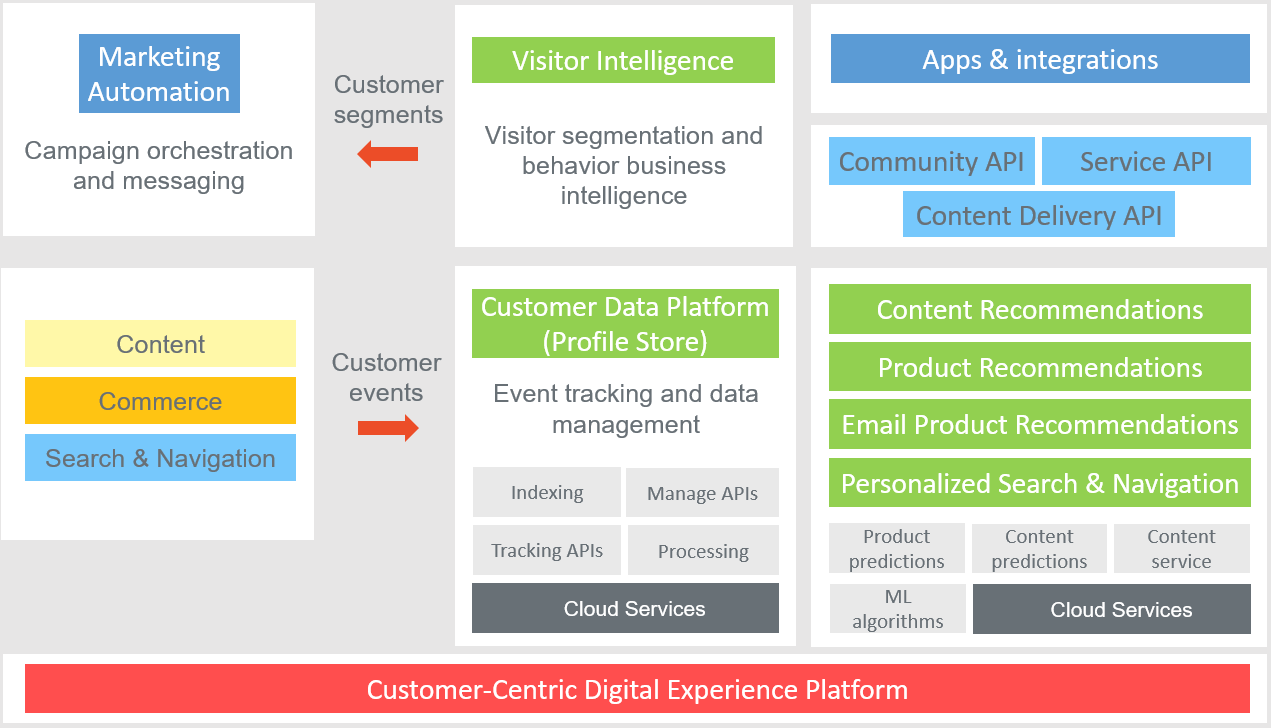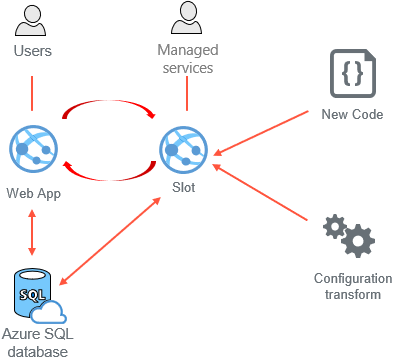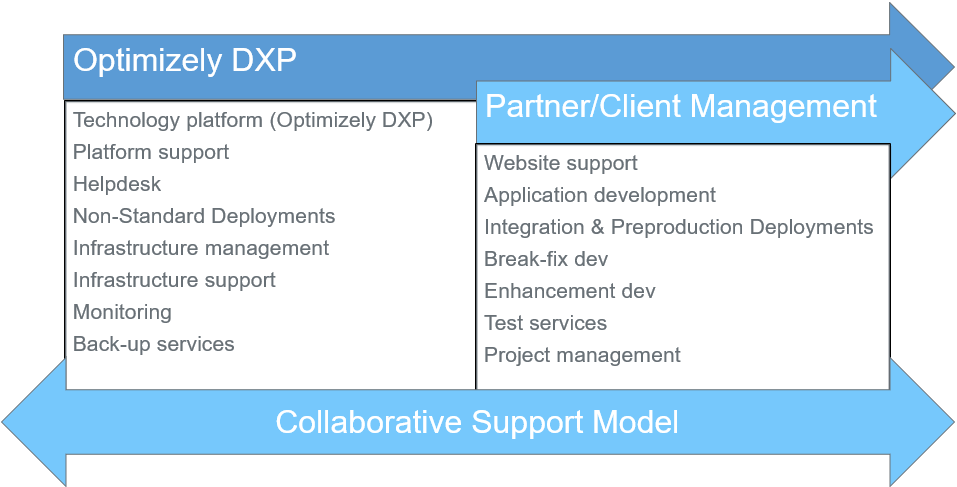Get started with DXP
Describes how to get started with Optimizely Digital Experience Platform (DXP). The onboarding process includes provisioning of environments and deployment setup. The onboarding steps are also described as part of the Cloud Accelerator Package.
With Optimizely, you can create truly customer-centric experiences using best-in-class CMS, robust ecommerce, and advanced personalization and marketing automation features.
Optimizely is based on a secure platform and multiple APIs and extensions, offering flexible customization and integration possibilities.
The Optimizely Digital Experience Platform is and end-to-end, full-stack digital platform service package that includes content management, digital marketing, enterprise search, and digital commerce in a single cloud service. The service ensures high availability and performance, with configuration and maintenance of required components included.

Prerequisites
- Knowledge of cloud-based development, particularly Microsoft Azure, is valuable for getting the most out of DXP. See Microsoft Azure to learn more.
- Before you start, ensure that you use compatible versions of software, services, and tools for a smooth deployment procedure.
- To access the Self-Service for DXP and information about your projects in the Azure portal, you need an Optimizely cloud account. See Create an Optimizely cloud account.
- Check the system requirements before installing. Easy installation and service onboarding, a set of sample templates and Visual Studio extensions, help you get your development projects running. With Optimizely's continuous releases, updates are available every week, you can keep projects up-to-date with a shorter time-to-market for customer solutions.
Differences between CMS and DXP
The difference between Optimizely CMS and Optimizely DXP is primarily in the range of features and functionalities they offer:
- Optimizely CMS
- Optimizely CMS is focused on content management, providing tools for creating, managing, and publishing digital content on websites.
- It allows users to manage web content easily and efficiently, providing a user-friendly interface for non-technical users.
- Key features include content editing, workflow management, and version control, targeting the needs of content creators and editors.
- Optimizely DXP (Digital Experience Platform)
- Optimizely DXP includes all the capabilities of Optimizely CMS but extends its functionality to provide a comprehensive digital experience solution.
- It integrates additional features such as personalization, experimentation, and analytics to deliver optimized and personalized experiences across multiple channels.
- The platform supports marketing automation, customer insights, and A/B testing, enabling businesses to engage users effectively and drive conversions.
- Optimizely DXP is designed for organizations looking to manage not just content but the entire digital experience across various touchpoints.
In summary, while Optimizely CMS is focused on content management, Optimizely DXP offers a broader suite of tools for managing and optimizing the entire digital experience.
DXP Dashboard
The DXP Dashboard provides an overview of your site's usage and performance. It includes self-service capabilities as part of your DXP, access to usage data, and availability for components associated with your subscription.


Service provisioning
When your order is provisioned and activated, a technical contact associated with your order receives an email from Optimizely with the following information:
- Default URLs for each of the environments included in your order.
- Contact information for support from Optimizely.
- Login credentials are needed to log in to the Optimizely environments.
- Contact information for support from Optimizely.
After receiving this information, you are ready to onboard and deploy websites.
Cloud accelerator package
The Cloud Accelerator Package enhances understanding of the Optimizely Digital Experience Platform (DXP). It provides tools to address technical and operational gaps, ensuring a smooth onboarding and deployment process.
This section shows the components of Cloud Accelerator.

1. Technical overview – kickoff
When an order is provisioned, and you have received the service provisioning information from Optimizely, a Customer Success project manager sets up a kickoff meeting. During this meeting, you review DXP services, roles and responsibilities, and steps to develop and launch to Production. Information also includes expectations for communication, processes, and deadlines.
In Optimizely DXP, a Web App is a solution built on the Optimizely platform and operating as an Azure Web App including an SQL Database, a BLOB storage, and an Optimizely Search & Navigation index. See Development considerations.
Separate environments ensure that your websites have developed and tested content before it is viewed in public. See also Environments.
- Integration environment – Involves the process of moving code and content between environments, such as from Development considerations to preproduction (UAT) to production, as part of a continuous deployment process. You can deploy Optimizely solutions using methods and tools supported by most development environments.
- Preproduction environment – A staging website where you test and assure the quality of content before it is transferred to the production environment.
- Production environment – The live, public website where editors and visitors interact with your website.
Elastic auto-scaling occurs when performance criteria are exceeded. There is no set number of servers, CPUs, or memory; extra allocation is provided when needed. If a sudden spike in activity occurs, capacity scales up quickly and scales back slowly as demand ebbs.
Note
To ensure seamless operation during upcoming campaigns or marketing events with anticipated high site traffic, you should open a proactive Support ticket 3 to 4 weeks in advance to give Optimizely time to assess your campaign's requirements and ascertain if supplementary resources are necessary for optimal performance.
A copy of the content called a "slot" is created during deployment. Configuration transforms are applied to the slot, and when it is verified, it is swapped with the content on the website for seamless interaction. See Deployment process.

2. Train to use DXP
Developing for the DXP_is a one-day training course where two seats are included with your Cloud Accelerator Package purchase. Persons attending this course should have skill equivalent to _CMS Development Fundamentals. See Optimizely Education Services.
3. Implement and load test monitoring
Deployment to Preproduction provides the opportunity to load test and validate sites before going live. Through the DXP Management Portal, you can access self-service functionality for deploying between environments. Features include:
- One-click deployment
- Configuration transforms
- Validations when deploying
- Maintenance page
- Deployment progress and details
- Error handling and logging
See DXP self-deployment guide.
Deployment scenarios
See Deploying and DXP self-deployment guide.
Testing
Review these recommendations:
4. Go Live Certification
Before deploying to Production, Optimizely ensures that everything on the following checklists is completed as part of the Go Live Certification.
Optimizely Managed Services task checklist
- Set up Pingdom monitoring.
- Set up Application Insights monitoring.
- Enter Reporting Pingdom and Application Insights CIs in the Omni tracker.
- Add the URLs for the above-created Pingdom alerts to the Zen Desk Pingdom Alerting CI App.
- Verify Application Insights is gathering and displaying data.
- Verify proper setup of the local cache before Go Live.
- Ensure auto-scaling is configured based on load test results.
- Ensure a proper number of default instances is configured based on load test results.
- Ensure a proper App Service plan is configured based on load test results.
- Ensure BLOBs are stored in the Azure storage account and not in AppData.
- Validate that SSL bindings are set up if required.
- Validate CDN is properly configured to receive traffic.
- If required, validate that the VPN is properly set up.
- Ensure DNS mapping verification is complete.
- Check the site with Host entry before DNS is mapped before Go Live (one working day in advance).
- Ensure application and system logging are enabled in the production environment and point to the appropriate BLOB containers (log-events and log-web).
- Verify that the cloud services packages are installed to configure for DXP.
- Ensure the website and cloud services have the starting instance count configured correctly and auto-scaling is set up and properly configured on production.
Partner or developer task checklist
- Review Going live.
- Set up development logging, see Logging.
DNS provider task checklist
- Reduce Time-to-Live (TTL) to 5 to 10 Minutes. This should take place several days before Go Live.
- Enter appropriate Go Live DNS records to cut over live traffic to the Microsoft Azure DNS app service.
Back-up and restore management
Optimizely provides redundancy precautions; see also Failover.
- Content Database
- Transaction log back-up every 5 minutes
- Full back-up hourly
- Point-in-time restore up to 35 days in the past
- Configuration and code
- Entire application back-up every 24 hours
- Configuration backup on the same schedule
- Azure Storage Accounts (BLOBs)
- Geo-Redundant
5. Go Live Support
Optimizely's Customer Success team provides support throughout onboarding until your site goes live. During onboarding, copy your onboarding Customer Success project manager on communications to ensure prompt assistance.
Responsibilities from Optimizely DXP Support and Partner or Client Management:

Optimizely's Support team is available throughout the onboarding process and after the launch of your website. Optimizely Managed Services Service Desk will support these service requests during business days:
- Non-standard deployments.
- CDN configuration changes.
- Placing IP addresses on the allow list.
- URL aliasing.
- DNS changes.
- Adding or removing user access.
- VPN configuration.
Contact information
- Email – [email protected] CC: Your onboarding project manager
- Web – Support Help Center (https://support.optimizely.com/)
- Phone –
- USA – +1-888-726-8127 or +1-877-383-0885 (Toll free)
- AU – +61 2 8036 3161
- UK – +44 (0) 800 066 4784 (Toll free)
- SWE – +46 8-555 827 50
Deployment scenarios
- Create a CMS site and deploy – I want to create a site based on the Optimizely CMS sample templatesand start development using Optimizely Digital Experience Platform.
- Deploy a CMS site –I have an existing Optimizely CMS site that I want to onboard to Optimizely Digital Experience Platform and continue to develop it using this service.
- Create a Customized Commerce site and deploy – I want to create a site with Optimizely Customized Commerce and start development using Optimizely Digital Experience Platform.
- Deploy a Customized Commerce site – I have an existing Optimizely Customized Commerce site that I want to onboard to Optimizely Digital Experience Platform (DXP) and continue to develop it using this service.
- Deploy code changes – I already use Optimizely DXP and have an existing site for which I want to deploy upgrades.
- DXP self-deployment guide
Related topics
- Request access to DXP Management Dashboard, Azure Portal Integration Environment, and Application Insights
- Access request form: Accessing Azure information
- DXP self-deployment guide
- Optimizely Support Portal
Note
Password self-reset is disabled. Email customer support to reset a password for you.
- Developer Documentation and Community for Optimizely
Note
When using the Optimizely World website for the first time, you will need to register. Password self-reset is disabled. Email customer support to reset a password for you.
- Visual Studio Publishing
- How to Restrict Access
- CDN Recommendations and Cache-control
- Partner or Developer – Set up Development Logging before go live
- Penetration Testing Rules of Engagement
- Optimizely Security Information
- RACI for Optimizely Services
- Blog post: Options for migrating to Optimizely DXP by David Knipe.
Updated 15 days ago